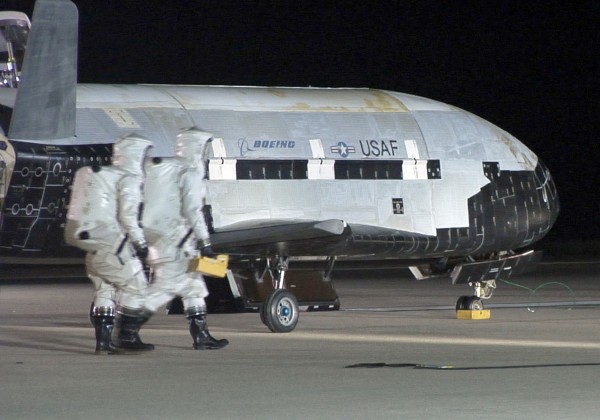X-37B Spy Space Plane Launches Tomorrow for Another Mystery Mission
| Ana Verayo | | May 19, 2015 02:30 AM EDT |
(Photo : United States Air Force/Michael Stonecypher/Wikimedia) The X-37B Orbital Test Vehicle sits on the runway during post-landing operations on Dec. 3, 2010 at Vandenberg Air Force Base.
The X-37B spy plane is preparing itself for liftoff for a new mission, launching on May 20, Wednesday where the nature of the highly secretive flight still remains a mystery.
This spy spacecraft is operated by the U.S. Air Force which is similar to the retired Space Shuttle. The X-37B is designed by Phantom Works under Boeing and measures 29 feet and possesses a 15 foot wingspan that currently holds a seven foot cargo bay.
Like Us on Facebook
This launch will be the fourth test flight carried out by the drone space plane which will be launched on board an Atlas 5 rocket designed by United Launch Alliance. The launch is scheduled on May 20, Wednesday between 10:45 A.M. to 2:45 P.M. EDT where mission controllers will announce the exact liftoff time on the day itself. According to weather experts, there will be a 60 percent chance of favorable conditions during the launch day.
Prior test flights of the spy space plane apparently logged in 1,368 days in space where the spacecrafts landed at the Vandenberg Air Force Base located in California which were all autonomously flown by robotic systems of the spacecraft. Overall, the previous three test flights spent more time in space than the combined 135 flights in the past 30 years that the Space Shuttle program was in operation.
According to Randy Walden who is the director of the Air Force Rapid Capabilities Office, this is another exciting launch for the fourth X-37B mission since the successful launches of the prior missions. This mission will now focus on testing the vehicle's capabilities of carrying out experimental payloads.
Officials from the U.S. Air Force will test several systems of the X-37B during this test flight including a new and crucial electrical propulsion system. This system will become the next generation technology to be used for the drone spacecraft which is a shift from the current Hall Current Thrusters used for communications satellites under the Department of Defense. This new propulsion system will utilize xenon gas in order to produce a small thrust that maintains satellites in lower Earth orbit.
These experimental payloads will include the Materials Exposure and Technology Innovation in Space (Metis) which will expose 100 material samples measuring just more than an inch in diameter to dangerous and harsh space conditions. This will test out how these various materials can withstand extreme temperatures in a vacuum environment.
According to Miria Finckenor who is the principal investigator for Metis at the Marshall Space Flight Center, this material exposure to space and then returning them to Earth can yield valuable data how they can survive in space environments.
Apart from this materials experiment, the launch will also carry the LightSail project by The Planetary Society which is the first test flight for the small spacecraft with sails that will use solar energy to glide through space.
TagsX-37B, U.S. Air Force, X-37B space plane robotic mystery mission launch, spy space plane launch mystery secret mission, X-37B space plane
©2015 Chinatopix All rights reserved. Do not reproduce without permission
EDITOR'S PICKS
-

Did the Trump administration just announce plans for a trade war with ‘hostile’ China and Russia?
-

US Senate passes Taiwan travel bill slammed by China
-

As Yan Sihong’s family grieves, here are other Chinese students who went missing abroad. Some have never been found
-

Beijing blasts Western critics who ‘smear China’ with the term sharp power
-

China Envoy Seeks to Defuse Tensions With U.S. as a Trade War Brews
-

Singapore's Deputy PM Provides Bitcoin Vote of Confidence Amid China's Blanket Bans
-

China warns investors over risks in overseas virtual currency trading
-

Chinese government most trustworthy: survey
-

Kashima Antlers On Course For Back-To-Back Titles
MOST POPULAR
LATEST NEWS
Zhou Yongkang: China's Former Security Chief Sentenced to Life in Prison

China's former Chief of the Ministry of Public Security, Zhou Yongkang, has been given a life sentence after he was found guilty of abusing his office, bribery and deliberately ... Full Article
TRENDING STORY

China Pork Prices Expected to Stabilize As The Supplies Recover

Elephone P9000 Smartphone is now on Sale on Amazon India

There's a Big Chance Cliffhangers Won't Still Be Resolved When Grey's Anatomy Season 13 Returns

Supreme Court Ruled on Samsung vs Apple Dispute for Patent Infringement

Microsoft Surface Pro 5 Rumors and Release Date: What is the Latest?










